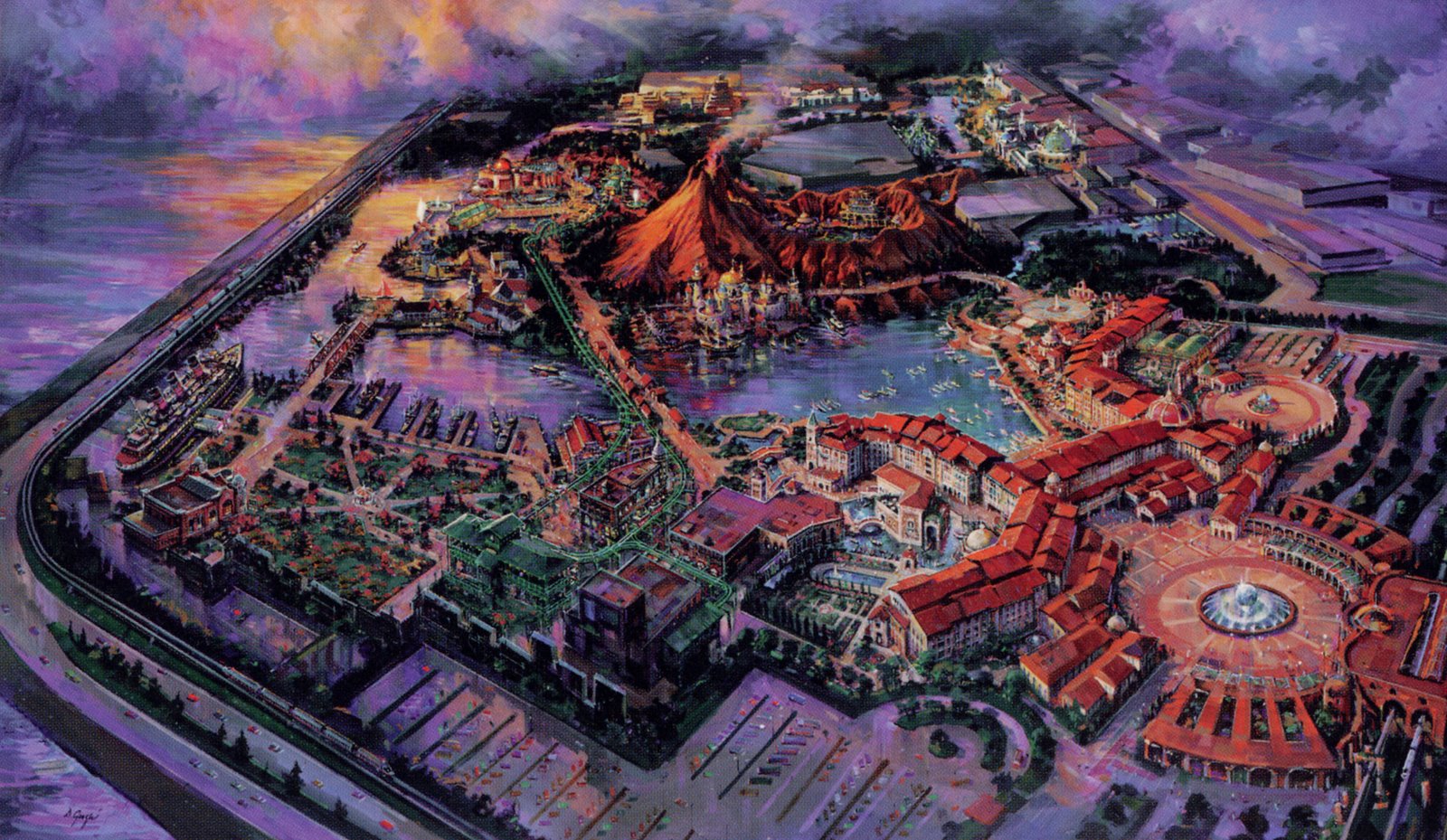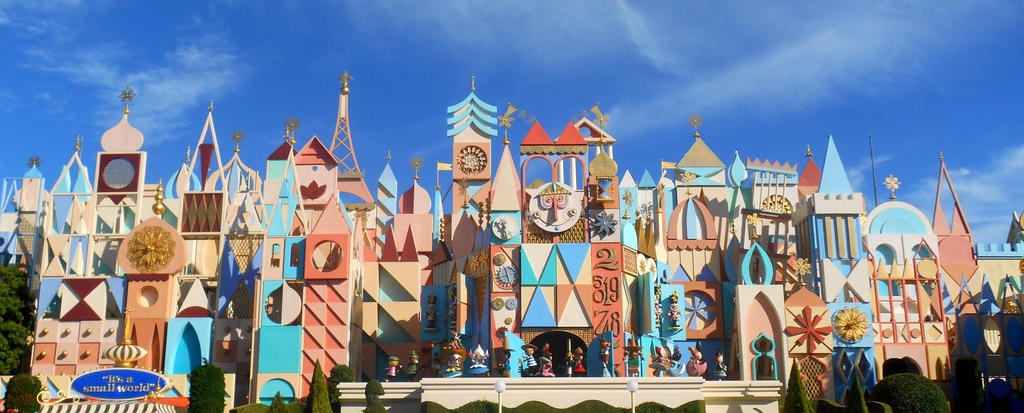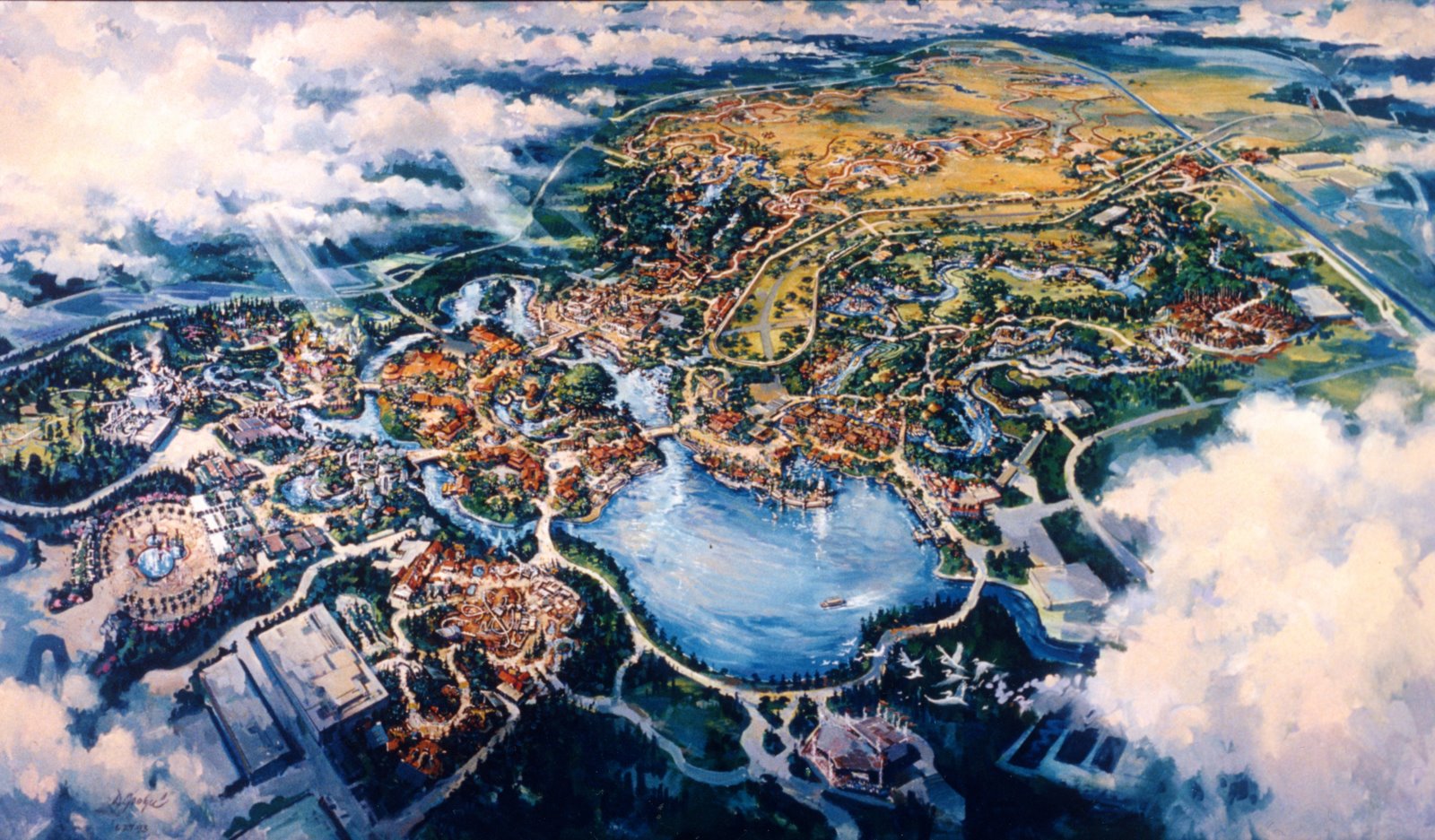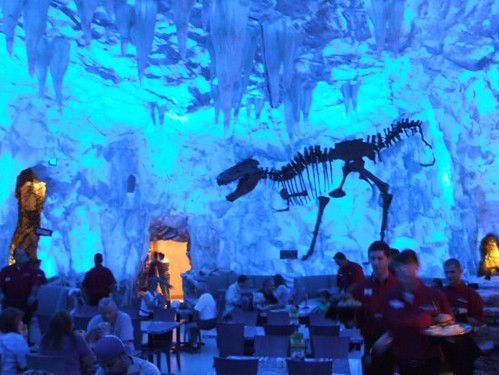"We go to the mountain for enlightenment, for self-realization, for adventure, for discovery. It's pregnant with meaning. When people see a mountain, they invest it with meaning. Not plot. Not character."
- Joe Rohde
"Walt said that I knew about colors he had never heard of!"
- Mary Blair

Fig. 1, Disney Sea Concept Art, time released unknown - What I personally would like to see is a next step by our community to further Imagineering's stride to have the man-made coexist with nature, and I think this piece of concept art emphasizes this idea, despite being on a much smaller scale.

Fig. 2, "It's A Small World" Attraction Facade, Tokyo Disneyland - This may not seem an appropriate fit for our park, but don't be afraid to be inspired by different attractions, or even different mediums, than usual; that's how truly great experiences are formed!

Fig. 3, Disney Animal Kingdom Concept Art, circa. 1995 - The closest source of inspiration I think to the tone that we could attempt to pull from for Disney Pangaea is DAK. However, new is always great, in my eyes, so if alternate directions are suggested, let's embrace them, no matter what stage we are in in development!
Project Background:- Joe Rohde
"Walt said that I knew about colors he had never heard of!"
- Mary Blair

Fig. 1, Disney Sea Concept Art, time released unknown - What I personally would like to see is a next step by our community to further Imagineering's stride to have the man-made coexist with nature, and I think this piece of concept art emphasizes this idea, despite being on a much smaller scale.

Fig. 2, "It's A Small World" Attraction Facade, Tokyo Disneyland - This may not seem an appropriate fit for our park, but don't be afraid to be inspired by different attractions, or even different mediums, than usual; that's how truly great experiences are formed!

Fig. 3, Disney Animal Kingdom Concept Art, circa. 1995 - The closest source of inspiration I think to the tone that we could attempt to pull from for Disney Pangaea is DAK. However, new is always great, in my eyes, so if alternate directions are suggested, let's embrace them, no matter what stage we are in in development!
If we thought Sydney Disneyland was an endeavor, what about being a park from scratch? It has been done on various scales ever since the Imagineering forum began to blossom, but never with the level of intricacies and nuisances that we achieved with Sydney. With that, this starts with two concepts, one that @Brer Oswald fathered and designed, and is really inspiring, and one that I have based on work I did with some great original Imagineers, @WED99, @Matt7187, and @RMichael21, starting all the way back in 2013.
The first:
As for my inspiration behind the initial concept, it started with an idea to reimagine It's a Small World. Funny enough, IaSW isn't an attraction I'm over enthusiastic about. But I imagined what it would be like if we turned it into a palace of sorts, a palace representing the Center of multiple cultures. When it got rejected for the first park, I immediately went back to the hypothetical drawing board. I came up with an idea that would incorporate different cultures and continents with the adventures (both fictional and non fictional) that could be found within them. The centrepiece of it all would be the Small World palace. The park takes inspiration from both Disney SEA and World Showcase, but not so much so that it's a copy of anything, no, it's its very own thing. I wanted the park to beable to stand on its own if it had to, so that it was not dependent on the other park in the resort (something that many secondary parks don't do, which I believe is a major drawback to the parks and their potential). This park could incorporate all the ideas that wouldn't fit in the other park. When people wanted to use other IP like Star Wars that didn't fit, I came up with the Prehistoric, Sea, and Space areas of the park, which will surround the continents section like a circle. I called it Disney's Pangaea because it represents one land that has multiple opportunities for adventure. I hope that's enough for inspiration!
The second is such:
It's been a while, so bare with me
Prompt:
Well, this is very, very open. But essentially, we will, in my eyes, replicate our process for Sydney Disneyland, but with a concept for Disney Pangaea. Everything should be considered, and any idea will be considered, as that's the beauty of starting from scratch!
Things to Note:
Mickey's Ten Commandments - Ten essential things to remember when designing anything Imagineering-wise, penned by the great Marty Sklar!
1. Know your audience. Don't overestimate what they may understand, but never underestimate and undermine the guest through this process.
2. Wear your guests' shoes. Leave no stone unturned, and create a full experience.
3. Organize the flow of people and ideas. Every great story has an order, so make sure to keep a logical thought process to bind your creativity together.
4. Create a "wienie," or visual magnet. Help this flow by doing so.
5. Communicate with visual literacy. Try your best to show, not tell us, with words, images, videos, interviews, song, dance, game, or any medium you find fitting, how something will work or act or be presented.
6. Avoid overload - create turn-ons. Keep a balance between a full environment and moments of sheer excitement.
7. Tell one story at a time. If we can dream it, we can do it, but just remember to return back to the logical side of things always to secure that idea. This does not mean not to dream big, just return to these steps to create your experience.
8. Avoid contradictions - maintain identity. We are always telling a story, so don't let things "break character."
9. For every ounce of treatment, provide a ton of treat. You can educate guests, just make it fun!
10. Keep it up! In our case, anticipate possible problems and come up with solutions to ensure a full design.
If anyone wants me to add things here, I gladly will try to do so!
Well, this is very, very open. But essentially, we will, in my eyes, replicate our process for Sydney Disneyland, but with a concept for Disney Pangaea. Everything should be considered, and any idea will be considered, as that's the beauty of starting from scratch!
Things to Note:
Mickey's Ten Commandments - Ten essential things to remember when designing anything Imagineering-wise, penned by the great Marty Sklar!
1. Know your audience. Don't overestimate what they may understand, but never underestimate and undermine the guest through this process.
2. Wear your guests' shoes. Leave no stone unturned, and create a full experience.
3. Organize the flow of people and ideas. Every great story has an order, so make sure to keep a logical thought process to bind your creativity together.
4. Create a "wienie," or visual magnet. Help this flow by doing so.
5. Communicate with visual literacy. Try your best to show, not tell us, with words, images, videos, interviews, song, dance, game, or any medium you find fitting, how something will work or act or be presented.
6. Avoid overload - create turn-ons. Keep a balance between a full environment and moments of sheer excitement.
7. Tell one story at a time. If we can dream it, we can do it, but just remember to return back to the logical side of things always to secure that idea. This does not mean not to dream big, just return to these steps to create your experience.
8. Avoid contradictions - maintain identity. We are always telling a story, so don't let things "break character."
9. For every ounce of treatment, provide a ton of treat. You can educate guests, just make it fun!
10. Keep it up! In our case, anticipate possible problems and come up with solutions to ensure a full design.
If anyone wants me to add things here, I gladly will try to do so!
Directory: Coming soon!
Well guys, this is it! I'm very eager to tackle this monster of a project, and after seeing Sydney Disneyland, I know we can do it if we work together!

Well guys, this is it! I'm very eager to tackle this monster of a project, and after seeing Sydney Disneyland, I know we can do it if we work together!







